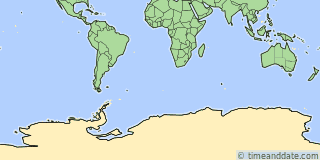Apr 5, 2026, 3:00 am
In some areas of Antarctica
| Country: | Antarctica |
|---|---|
| Abbreviations: | AQ, ATA |
| Time Zones: | 24+ |
Note: Only some parts of Antarctica used DST in 2014.
Apr 6
Back 1 hour
Apr 6, 2014 - Daylight Saving Time Ended
When local daylight time was about to reach
Sunday, April 6, 2014, 3:00:00 am clocks were turned backward 1 hour to
Sunday, April 6, 2014, 2:00:00 am local standard time instead.
Sunrise and sunset were about 1 hour earlier on Apr 6, 2014 than the day before. There was more light in the morning and less light in the evening.
Also called Fall Back and Winter Time.
Sep 28
Forward 1 hour
Sep 28, 2014 - Daylight Saving Time Started
When local standard time was about to reach
Sunday, September 28, 2014, 2:00:00 am clocks were turned forward 1 hour to
Sunday, September 28, 2014, 3:00:00 am local daylight time instead.
Sunrise and sunset were about 1 hour later on Sep 28, 2014 than the day before. There was more light in the evening and less light in the morning.
Also called Spring Forward, Summer Time, and Daylight Savings Time.
Is there Daylight Saving Time in Antarctica?
Although most research stations in Antarctica lie within the Antarctic Circle where Daylight Saving Time (DST) does not make sense as a measure to conserve energy, some of them change their clocks every year to stay in sync with the countries that operate or supply them. The date of the change may also vary, depending on supply boats or flights. For this reason, Daylight Saving Time changes in Antarctica are often labeled as preliminary.
Vostok Station, for example, doesn't use DST as it is in the Antarctic Circle and experiences 24 hours of sunlight during the summer and 24 hours of darkness in the winter.
McMurdo Station, however, follows New Zealand Standard Time (NZST) during standard time and New Zealand Daylight Time (NZDT) during the DST period in New Zealand.
The Norwegian research station Troll changes between Greenwich Mean Time (GMT) during standard time, and Central European Summer Time (CEST) during the DST-period.
Casey Station changes between UTC+8 in the winter season and UTC+11 in the summer season. The Australian station's time changes line up—for the most part—with the switch to DST in Australia. So, when Tasmania sets the clocks forward one hour for DST to UTC+11, Casey set their clocks forward three hours to UTC+11.
Which States use Daylight Saving Time in 2014

Areas in Antarctica on standard time all of 2014
DST in Locations in Antarctica in 2014 (19 Locations) | |||||
|---|---|---|---|---|---|
| Belgrano II Base | No DST | Marambio Base | No DST | Rothera Research Station | No DST |
| Carlini Base | No DST | Mario Zucchelli Station | Sep 28 – Apr 6 | San Martín Base | No DST |
| Casey | No DST | Mawson | No DST | South Pole | Sep 28 – Apr 6 |
| Concordia Station | No DST | McMurdo | Sep 28 – Apr 6 | Troll Station | Mar 1 – Oct 26 |
| Davis | No DST | Neumayer-Station III | No DST | Vostok Station | No DST |
| Dumont d'Urville Station | No DST | Orcadas | No DST | ||
| Esperanza Base | No DST | Palmer Station | Sep 7 – Apr 27 | ||
Daylight Saving Time History in Antarctica
- Antarctica first observed Daylight Saving Time in 1930.
- Antarctica has observed DST for 92 years between 1930 and 2025 (DST in at least one location).
- Previous time with no Daylight Saving Time was 1973.
- See Worldwide DST Statistics
